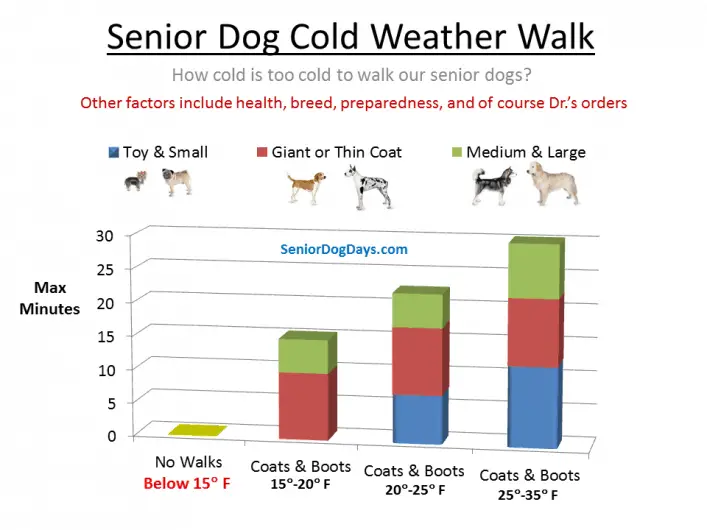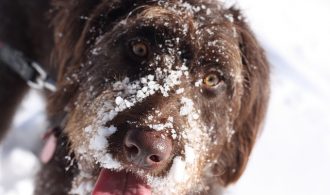Some content may contain affiliate links to products which means we could earn a fee on your purchase. Thank you for visiting
While age isn’t the only factor to consider it’s an important one. What’s cold for one dog may feel like springtime the next.
But to answer your question: “can I walk an old dog in cold wheather” there is one good rule to live by concerning our senior dogs:
0° – 15° F – Senior Dogs should skip the walk
Senior Dog Walk Chart Reference

Here is one thing for certain: my dog has never looked out the window and concluded that a walk was too risky. Meaning he always wants to go and gets rather disappointed when we can’t.
But, it’s up to us to do a better job of identifying problem areas. And as our older dogs journey into their senior years, walking in the cold can have some serious negative effects…but what exactly is COLD?
Define: TOO Cold for a Dog Walk
I was speaking with my parents yesterday and my mom expressed a bit of cabin fever frustration because it’s been so cold in Florida. “Really?” I asked. “How Cold?” to which she resolutely replied “in the fifties!” Okay, Fifties to someone in Buffalo is when we bring out the shorts!
So, we know that cold is relative. Let’s go ahead and define it for the purpose of this article and say by “cold”, we mean anywhere between 0 and 40 degrees Fahrenheit.
Let’s explore what precautions we can take to make senior dogs more comfortable when we walk them in the cold.
Cold Walks and Arthritic Senior Dogs
Even if you’ve got a Malamute or Husky, once you’re caring for a senior dog, taking a walk in cold weather requires thought and planning.
It’s not just about the cold at that moment, but how cold affects him over the next few days. We also need to recognize that one little slip on an icy sidewalk could mean weeks of pain or permanent immobility for our senior dogs.
When it comes to senior dogs or an old dog going for a walk in the cold, follow these guidelines:
15° and below, skip the walk regardless of your dog’s breed or size
15-20° With Cold Gear like coats and boots
- Toy & Small skip it
- Giant Breeds or Thin coat – under 10 minutes
- Medium and Large 15 minutes
20-25° With Cold Gear
- Toy & Small 5 minutes
- Giant or Thin coat 15 minutes
- Medium and Large 20-25 minutes
25-35° With Cold Gear
- Toy & Small 10 minutes
- Giant & Thin Coat 20 minutes
- Medium and Large about 30 minutes
Exercising With Consecutive Zero Degree Days
Since exercise remains an important pillar in our senior dog’s overall health and mobility, walks remain important.
Stiff joints and loss of muscle progress rapidly and reversing these problems becomes nearly impossible as they age. Just because it’s too cold or too icy to take it outside, doesn’t mean we skip the exercise.
If you’re living in North Carolina and experience a cold-snap, it makes sense to just wait until tomorrow and keep your senior dog inside.
However, if you’re living in Buffalo, NY or Quebec Canada, you cannot go all winter long waiting for better days…they’re not coming. You’ve got to think of ways to keep your senior dog moving. Here are some ideas:
Pet-Friendly Stores – just like malls cater to “mall-walkers” you can drive to Dog Friendly Stores and walk the aisles.
PetSmart, PetSupplies Plus, Gander Outdoors, HomeDepot, and BassPro are just a handful of places where you can take your senior dog for a walk in the comfort of heat.
Verify before you go and then make it a part of your day. Of course indoor dog etiquette applies and you still have to look out for them, but it’s a great alternative to ‘not walking at all.’
If you can’t get out to alternative walking places, try playing a game that involves walking around the house.
One of my favorite things to do with Frodo is hide treats all over the house and then tell him “go find them!” This activity can keep him occupied for about 15 minutes (I hide a lot). Put them upstairs and downstairs inside a boot, under his rug, in his toybox, etc.,
This is a great alternative when you have to skip a walk due to bad weather, but what a way to make it up to him! What’s important here is that your senior dog isn’t left to sleep all day during these cold snaps. Keep her moving!
And when the polar vortex subsides and temperatures climb to a safer level, you can resume walking outdoors.
Regardless of breed, coat density, overall health, your senior dog should have a few staples….just as humans do.
Invest in High Quality, Cold Weather Dog Walking Gear
While there are a lot of products making their way to the shelves these days (and failing), the most important investments to concern yourself with when it comes to cold weather walking are:
- An appropriate sized sweater or jacket
- Senior Pad Paw Protection
- Safe Leash Connections
When making these purchases, you want high quality items with consistent high reviews. The best products improve safety while standing up to the damaging affects of snow, sleet, salt and extreme temperature changes.
Senior Dog Sweaters and Jackets
Have fun getting stylish! If your dog isn’t blessed with a thick coat or is bothered by the cold then have fun adding a sweater or coat to her wardrobe. If you walk a few times a day, have several on hand, so you can use a dry sweater or coat each time your dog goes outside. We all know that wet clothing makes us colder and would defeat the purpose.
When fitting your dog, always size up and not down. A constricted dog cannot walk properly, may have trouble doing “business” and you don’t want to cut off circulation.
Senior Pad and Paw Protection
Let’s face it; our senior dogs aren’t walking and running as much and their paws can become hard and cracked or soft and sensitive. Either way, especially when it’s cold, wet, or snowy, we should make an effort to protect their paws from getting any worse.
Getting rock salt in the cracks of a calloused paw hurts just as much as having it eat away at a soft pad. It’s our job to keep the paws safe and prevent any further complications with their mobility.
The name of the game is: Traction
Cold and snow breed dogs can have a huge advantage when it comes to cold tolerance but even they cannot conquer icy pavement.
Snow dog’s feet are made for “snow” – as in: snow covered roads. No dog’s paws are made for slick, icy sheets on a sidewalk. Everyone needs traction.
Paw Balms and Boots
Balms – Lots of dog owners swear by applying paw balms before a they walk an old dog in cold weather. In my experience, balms have a tendency to make paws slightly slippery.
Since my dog is a senior and suffers from arthritis, I no longer use balms as a barrier to the elements because I don’t want him to suffer a fall from slippery paws.
I do like balms, however, for regular paw maintenance, such as “overnight treatment for cracked or dry paws. When using balm overnight, I slip a green rubber bootie over his paw in case he gets up in the middle of the night. We don’t want any wipe outs!
Boots –So speaking of boots, my old dog wears two styles for his cold, winter walk.
- Rubber (thick balloon style) for wet, salty conditions, or times when I want to protect a cracked paw
- Structured, (soft material but formed) for cold, slippery weather conditions, including ice.
For the rubber balloon style boots, I like the ones called PAWZ. They actually stay on my dog’s big feet until I take them off.
For the structured boots, I like the soft structured style that uses Velcro strap closures.
It’s worth mentioning that my dog doesn’t like either of them when I put them on and does his best Clydesdale impersonation. However, he gets over it pretty quickly. Once we are outside walking, he walks normally and he pays them no attention.
Safe Winter Walking Dog Leash Connections
While you shouldn’t be out walking in icy conditions, you don’t always know when you’re heading straight for a sheet of black ice. One thing is for sure, if you fall, you don’t want to make your senior dog fall and vice-versa.
For the safest winter walking, connecting to each other should be done at your cores, not between their neck and your wrist. For the human it’s at the waist and for your dog, it’s near her shoulder blades.
Hands-Free Dog Leash -Human Connection
For the human, if you haven’t been converted yet, consider a hands free leash for winter walking. Your core will absorb any pulling and makes you both more stable when walking on the ice. Plus you’ll get full use of your arms which also helps to maintain your balance if you happen upon an icy spot.
Once you go hands free, you may wonder why you didn’t do it years ago. Once I tried a hands free leash, I felt a beautiful harmony and now it’s my primary walking leash.
Hands-Free Dog Leash Canine Connection
For your Senior Dog, you might consider a harness that connects to his core at the back/top of his shoulders. Imagine the strain on his neck if you or he falls with a leash attached to his neck?
Free Improvements For a Walk in the Cold with an Old Dog
Simple things that involve absolutely no money and will help keep your dog protected in the cold weather walks
Hydrate – Many of our dogs are on limited water or interval water bowls because as they get older, they gulp and toss their water.
Right before you walk an old dog in cold weather, make sure she gets a good healthy drink of water. You don’t want her eating snow.
Snow is NOT a good source of water for your senior dog as you have no idea what’s lurking.
Trim Nails – long nails increase the chances of her slipping and sliding on floors and definitely ice. Make sure her nails are not touching the ground or running interference with her natural ability he steady herself. Read more about senior dog nail trimming.
Trim paw hair between toes – You haven’t lived until you’ve spent time cursing and picking ice balls out from in between your dog’s toes. These little ice balls are the most resilient forms of ice I’ve ever seen. To top it off, they can really irritate a “tender- footed” dog, like my Frodo.
Clipping the toe fur flush with the toe actually does help. For more comfortable winter walking, keep hair between your dog’s toes clipped short.
Ice can accumulate on this hair, causing temporary lameness or making it difficult or painful for your dog to walk. This is why boots are a worthwhile investment.
Post Walk Paw Bucket – People use all kinds of products to melt ice on their sidewalk, ranging from fertilizer to antifreeze, things you don’t want your dog ingesting.
Right after a walk you’ll need to remove the salt and toxins from her paws. Have a baby bucket or shallow tray reserved especially for this purpose. Fill it with warm water and give each paw a dip.
Safely Melt Ice with Dog Friendly Ice Melter
Choose pet safe products on your own steps – If you’re buying ice melters for your own home, use the pet friendly kind.
Most chemical ice-melts are not safe for pets. Choose a non-toxic, pet-friendly traction product, such as SafePaw, Green Gobbler or Ecotraction.
Most chemical ice-melts are not good for kids, birds, gardens or lawns, either, so everyone benefits when you upgrade..
Summary
Don’t Risk it
I know it’s temping to walk your old dog in the cold. Your dog is staring into your eyes. You know and she knows exactly what time it is. Problem is; it’s 5 degrees and slippery.
While you’ll never convince your dog that it’s for his own good, postponing a walk due to cold and ice is the right decision for a senior dog.
Just like our human seniors, one slip could spiral into a whole series of painful, debilitating health conditions.
“Live to see another walk” is a good philosophy to embrace. But it doesn’t mean skip the exercise.
Find a way to get her moving; like hunting through the house for treats or getting some exercise in a pet-friendly store. Try these helpful articles for even more ideas: Senior Dog Entertainment and 10 Fun Things for Senior Pups.
And if you haven’t outfitted your dog with weather appropriate coats and boots, the time is now. If money is tight, shop sales or request them as Christmas or birthday presents
With boots and coats, it’s a lot easier, safer and more enjoyable to walk your old dog in the cold.
Thanks for visiting!

